SUBLIME POTENTIAL
"The dark day and the bright day, the two realms of space, turn by their own wisdom."
--Rig Veda [Book VI, Hymn IX]
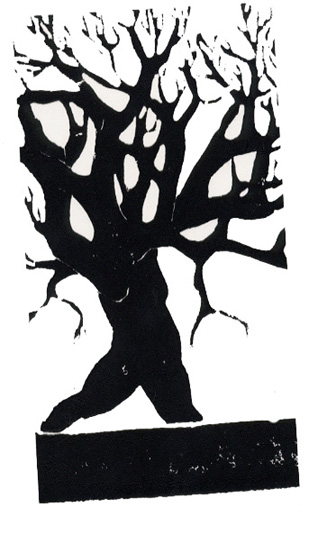 PART I: LINGUISTIC PIXIE DUST
PART I: LINGUISTIC PIXIE DUSTPART II: DIVING INTO STARS
PART III: THE ART OF NEGATION
PART IV: EPISTEME UPON EPISTEME
PART V: OUTTAKES
I. Linguistic Pixie Dust
Amalgams, archiphonemes, functional loads, metatheses, minimal pairs, morphophonemics -- the language of contemporary linguistics. Since Saussure and Jakobson, Martinet and Chomsky, the structure of natural language has been thoroughly investigated yielding a wide array of descriptive and analytical substructures. Chomsky's current "minimalist program" -- following on his quest for deep structures and an elaboration of his theory of generative grammar -- includes a system of almost poetic descriptives. These terminologies include: Principles and Parameters (P&P), Universal Grammar (UG), Structural Descriptions (SDs), E-Language (formal sets), and I-Language -- a range of figures denoting the highly abstract and the entirely discrete mechanisms of the linguistic landscape. They suggest a sublime 'interior' landscape buried in the troubled and tragic human encounter with the world.
Image (above, left) - Gavin Keeney, "Dancing Tree", Wood-block print on rice paper, c. 1976
"A language is not, then, a system of rules, but a set of specifications for parameters in an invariant system of principles of Universal Grammar (UG); and traditional grammatical constructions are perhaps best regarded as taxonomic epi-phenomena, collections of structures resulting from the interaction of fixed principles with parameters set one or another way." --Noam Chomsky, The Minimalist Program (MIT Press, 1995), p. 129.
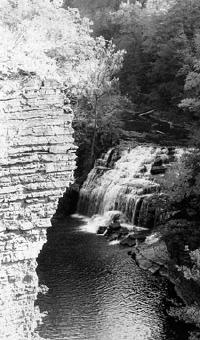 This précis sets out the agenda for a phenomenology of language that has parallel operations in other fields, including landscape. Chomsky's system acknowledges, significantly, that language is a component of the natural world. Language is generated from a base of phonetic and semantic properties contained in the lexicon and elaborated in subsequent structural operations. I-Language is the foundational, interior, personal field of such operations. In the analytical processes of linguistic theory I-Language yields to a computational system (which is itself contained in the I-Language). Syntax (including phonology) "provides three fundamental levels of representation, each constituting an 'interface' of the grammatical system with some other system of the mind/brain: D-Structure, phonetic form (PF), and Logical Form (LF)." (p. 130) D-Structure expresses lexical properties in a form accessible to the computational system [...] (p. 20) For Chomsky, this complex of semantic and phonetic properties equals the expressive nature of a language. Grammar, itself, equals the theory of a specific language. Universal Grammar equals the theory of all languages, linguistics per se. Landscape and linguistics are ever so closely allied in the human experience and this minimalist program is more than analogous to certain types of landscape expression -- it is the radical unearthing of the motivational forms of natural and designed landscapes.
This précis sets out the agenda for a phenomenology of language that has parallel operations in other fields, including landscape. Chomsky's system acknowledges, significantly, that language is a component of the natural world. Language is generated from a base of phonetic and semantic properties contained in the lexicon and elaborated in subsequent structural operations. I-Language is the foundational, interior, personal field of such operations. In the analytical processes of linguistic theory I-Language yields to a computational system (which is itself contained in the I-Language). Syntax (including phonology) "provides three fundamental levels of representation, each constituting an 'interface' of the grammatical system with some other system of the mind/brain: D-Structure, phonetic form (PF), and Logical Form (LF)." (p. 130) D-Structure expresses lexical properties in a form accessible to the computational system [...] (p. 20) For Chomsky, this complex of semantic and phonetic properties equals the expressive nature of a language. Grammar, itself, equals the theory of a specific language. Universal Grammar equals the theory of all languages, linguistics per se. Landscape and linguistics are ever so closely allied in the human experience and this minimalist program is more than analogous to certain types of landscape expression -- it is the radical unearthing of the motivational forms of natural and designed landscapes.Image (above, left) - Gavin Keeney, "Gorge", Ithaca, New York, c. 1989
Wittgenstein also spoke of deep grammar and surface grammar, and to this we will return. Meanwhile, "Suppose that the arguments that have been advanced against the existence of a phonemic level could be surmounted within another conceptual framework. That would not be a return [...] but an advance." Chomsky, On Language (1998), p. 177. In structuralist phonology, once the structure of language is unearthed so-called "generative" grammar begins. This excavation of language, and its phonetic jouissance, has a long lineage. Roman Jakobson, in particular, has provided the soundings of this embedded structure, for example, "The Spell of Speech Sounds" in Sound Shape of Language (Bloomington, IN, Indiana University Press, 1979). There are significant finds in this taxonomic digging and sifting ... Jakobson, rightly, corrected the perception that the discursive apparatus of semiology is anything new by showing the origin of Saussure's dyad 'signified' and 'signifier' in the 2000-year-old Stoic tradition. The sign (signa) contains both 'signans and signatum'. Attendant dissociations within phonemes and binary operations -- the signature discovery of structural analysis -- have evolved from this very old root. Saussure's discussion of "linguistic dust" (poussière linguistique) -- the occurrence of rare doublets in linguistic substructures -- is a perhaps useful starting point for a detour into landscape. Doublets are strange anomalies in the semantic field of a given language that suggest that language is an amalgam of unstable signifiers, at the least, and a place where nature and landscape + architecture enter into a subjective 'pas de deux' replete with fruitful recombinations, displacements and transformations. A search there might flush (flesh) out a fugitive radical dimension within landscape + architecture that is ever-present, but ever-suppressed. This dimension, by further twists and turns, might reconnect human experience to the vital state of Being-for-the-World.
II. Diving into Stars
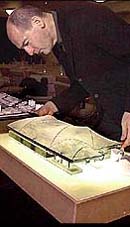 The present-day wager on materialist and utilitarian operations is a conventional appropriation of anti-humanist rhetoric -- an earnest appeal to the latent desire of the architectural object/body for things heterogeneous but strictly nominal. This nominalism excludes the sublime and only ever represents the ideal as an image -- or sign -- without content. This is the outcome of a metaphysics that tragically subdivides the world. Content is the deferred, denatured and depleted surface of things or structure without its most radical other -- the sublime (the in-dwelling). The sublime remains at a maximum distance in such orders, as mechanisms only become sublime when they fail or inexplicably turn upon themselves and yield unforeseen expressions of a certain je ne sais quoi -- the here-again-gone-again 'nature' of the sublime other.
The present-day wager on materialist and utilitarian operations is a conventional appropriation of anti-humanist rhetoric -- an earnest appeal to the latent desire of the architectural object/body for things heterogeneous but strictly nominal. This nominalism excludes the sublime and only ever represents the ideal as an image -- or sign -- without content. This is the outcome of a metaphysics that tragically subdivides the world. Content is the deferred, denatured and depleted surface of things or structure without its most radical other -- the sublime (the in-dwelling). The sublime remains at a maximum distance in such orders, as mechanisms only become sublime when they fail or inexplicably turn upon themselves and yield unforeseen expressions of a certain je ne sais quoi -- the here-again-gone-again 'nature' of the sublime other.Image (above, left) - Rem Koolhaas' "LACMA" model (Los Angeles County Museum of Art)
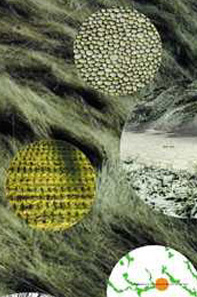 Linking high and low in structural operations may perchance reveal the underlying or meta-tactical (secret) effulgence that underwrites discursive, horizontal systems. The openings to a 'beyond' or a 'below' are sufficiently irrepressible to guarantee that the most stringent nominalist project will burst, in time, with its own inherent (suppressed) surplus -- the sublime or infinite vistas contained in the amalgam. This unmappable 'universal grammar' of interlocking systems contains entirely other worlds and substructures that enfold and hold in thrall the mysterious unstoppable excess of material operations. These operations are currently the sensation of the moment only insofar as other moments may be discredited and/or sublimated. The sublime reappears at the liminal, threshold condition and site of generation -- that superlative edge of things referred to, pace Plato, as the 'space of appearance' or the 'chora' in phenomenology. This age-old (age-less) site is the origin of all figures and figuration, fissures and forms, and represents the hypostasized condition of 'intent' or, conversely, the sublime potential of instrumental systems. This is the interface of worlds, the platform of departures near and far, the place where presence-and-absence shows its Janus-like face. One selects from this place, as design professional, a two-way or one-way mask (mirror) to present to the world.
Linking high and low in structural operations may perchance reveal the underlying or meta-tactical (secret) effulgence that underwrites discursive, horizontal systems. The openings to a 'beyond' or a 'below' are sufficiently irrepressible to guarantee that the most stringent nominalist project will burst, in time, with its own inherent (suppressed) surplus -- the sublime or infinite vistas contained in the amalgam. This unmappable 'universal grammar' of interlocking systems contains entirely other worlds and substructures that enfold and hold in thrall the mysterious unstoppable excess of material operations. These operations are currently the sensation of the moment only insofar as other moments may be discredited and/or sublimated. The sublime reappears at the liminal, threshold condition and site of generation -- that superlative edge of things referred to, pace Plato, as the 'space of appearance' or the 'chora' in phenomenology. This age-old (age-less) site is the origin of all figures and figuration, fissures and forms, and represents the hypostasized condition of 'intent' or, conversely, the sublime potential of instrumental systems. This is the interface of worlds, the platform of departures near and far, the place where presence-and-absence shows its Janus-like face. One selects from this place, as design professional, a two-way or one-way mask (mirror) to present to the world.Image (above, right) - OMA/Mau's, "Tree City" (detail), Parc Downsview Park Competition (Toronto), c. 2000
III. The Art of Negation
Let us celebrate reversing trends, negating fashions, and nixing compromises with utilitarianism and pragmatism. It is not enough to privilege minimalism and its autistic codes; the necessary conflict of fighting fire with fire requires more strenuous measures. Minimalism is merely a cool, numbing, sub-pre-linguistic territory that instills quietude -- quiescence -- versus resistance and renovation. It is the mute territory of phonemes. It also passes passively into the annals of fashion and style with ease and considerable elan.
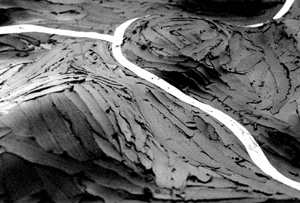 We propose, instead, the excess of loveliness -- of the minimal -- through an excavation, stripping away, of the vulgar or ordinary to reveal a commonality that is uncommon, uncanny even, and an interface for the immense complications -- noise -- 'on the other side' of the object and the figure. This is the world of hyper-intertextuality. This favors the slippery and the phantasmatic -- the serious and grave, stringent and suave -- markings in time of vast other places, things, and concepts. These markings are 'footnotes' of the sublime, of the material that does not fit into the prose or journalistic rapport of most design idioms, and that simply cannot be accommodated whatsoever except as a fleeting, ghostly something. Such things will remain forever outside the object, but through stripping and sifting return in the extreme ambient matrix of voluble signifiers. They are presented simply by the act of not obscuring them.
We propose, instead, the excess of loveliness -- of the minimal -- through an excavation, stripping away, of the vulgar or ordinary to reveal a commonality that is uncommon, uncanny even, and an interface for the immense complications -- noise -- 'on the other side' of the object and the figure. This is the world of hyper-intertextuality. This favors the slippery and the phantasmatic -- the serious and grave, stringent and suave -- markings in time of vast other places, things, and concepts. These markings are 'footnotes' of the sublime, of the material that does not fit into the prose or journalistic rapport of most design idioms, and that simply cannot be accommodated whatsoever except as a fleeting, ghostly something. Such things will remain forever outside the object, but through stripping and sifting return in the extreme ambient matrix of voluble signifiers. They are presented simply by the act of not obscuring them.Image (above, left) - Gavin Keeney, "Generic Plasticene Model", c. 1990
Such measures imply exemplary (and extreme) intertextual outings and/or grandiloquent appropriations of apparently unrelated and extraneous genres and disciplines. Such activities make most people ill. However, the fearlessness of this quest for protean fire must outstrip the conventional and cautionary tales of the guilty and colluding ravens of the hour. And they know who they are ... To strip away the layers of deceit and structural anomie will reveal the beneficiaries of the same. Neither cause nor effect will go quietly. The reversible, the recondite, and the real are buried in the didactic, diurnal machinations of magpies. It is so, and it has always been so. It need not be so, and, therefore, the sojourn elsewhere begins here in the absolutely quotidian, ordinary confines of the 'just so'.
Stringent measures are required, very large erasers (erasures), and number nil graphite pencils ground to a stub. Whole lines, run-on paragraphs and propositions, treasured locutions and clever clauses, excuses of craft, haughty self-congratulatory treatises and endless bylaws and wherefores are to be scraped away and sent packing into oblivion -- a field day for vultures, if you will.
IV. Episteme upon Episteme
Landscape + architecture needs to destroy the formal languages that hold it in thrall, that have destroyed the im-mediate and im-manent nature of landscape itself -- im-materiality, im-modesty and imagination all miraculously merge in the synchronic plenitude of immanence. The one-time blessing in disguise (the blessed curse) of modernist abstraction -- and its quest for the transcendent, the Absolute -- is overturned (inverted) through the re-emergence of immanence. Paradoxically, the reduction of architectonic mediation to its essence as a form of linguistic pixie dust is the return of the Absolute from exile; from the distant lands of abstraction and positivism, and from the wasteland of dialectical operations (metaphysics).
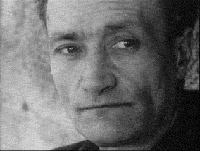 The key is -- alas -- language. And, as with Artaud's critique of theater, the problem is the over-reliance on speech (semantics) itself. In the little world of landscape architecture the problem is, ironically, the derelict state of design syntax -- form without semantic value. The empty formalism of most contemporary landscape architecture is the late reification of the modernist curse. The cause of this curse is the empty vessel of landscape practice. Once smashed, this vessel -- which is not unlike a barren tree -- will liberate vast repressed potential (fire-works). The future is landscape + architecture.
The key is -- alas -- language. And, as with Artaud's critique of theater, the problem is the over-reliance on speech (semantics) itself. In the little world of landscape architecture the problem is, ironically, the derelict state of design syntax -- form without semantic value. The empty formalism of most contemporary landscape architecture is the late reification of the modernist curse. The cause of this curse is the empty vessel of landscape practice. Once smashed, this vessel -- which is not unlike a barren tree -- will liberate vast repressed potential (fire-works). The future is landscape + architecture.Image (above, right) - Antonin Artaud


Prolegomena to Every Future Landscape Architecture
Gavin Keeney (2001)
Regarding the ‘sign’ of Infinity Doubled, see Infinity Doubled (RTF) and Thought Itself (RTF) ...
A version of this essay, applied to the landscape-architectural work of Room 4.1.3 (Australia) will appear in late 2004 in Room 4.1.3: Innovations in Landscape Architecture (Philadelphia: University of Pennsylvania Press, 2004) ... / For details of this publication, cliquez ici ...
V. OUTTAKES / SMALL PRINT
“In contemporary architecture, the poetics of de-materialization play on surface mystery, uncertainty of perception, ambiguity and illusion to convey the ‘aesthetics of virtual reality’ that Jean Nouvel spoke of with regard to his Fondation Cartier, where tall dark glass panels reflect and multiply images and layers. Matter is thus not so much a means of defining the limits of the building as of liberating perception, introducing vibration and a host of changing and fragile readings, opening the way to the invisible and to emotion. In this ‘aesthetics of the miracle’ as described by the architect, mystery remains entire, the result is present but we are not aware of the means to achieve it, our emotion derives from perception of a building ‘set free’, which offers itself to our regard like an object, an inhabited painting.” Salwa & Selma Mirou, “Oraisons modernes”, L’Architecture d’Aujourd’hui 356 (January-February 2005), p. 53 / “The medium must disappear in what we see, in the absolute that shows itself resplendent in it.” Giorgio Agamben, Image et Mémoire (Paris: Desclée de Brouwer, 2004), cited in the “Oraisons modernes”
 "To the questions, prejudices and hesitations about the discipline becoming a false science, a form of anthropology, a strict yet poor geology, a material economy, a flat ecology, a quick biology or a clumsy meteorology, the most richly machinic moments of these projects give evidence that that is only a conservative myth, and that the discipline is just growing, slowly, to catch up with other forms of knowledge, probably with the secret, ingenuous and harmless purpose of taking over." --Ciro Najle, "Weather Report", Parc Downsview Park (in Juncus, 2000)
"To the questions, prejudices and hesitations about the discipline becoming a false science, a form of anthropology, a strict yet poor geology, a material economy, a flat ecology, a quick biology or a clumsy meteorology, the most richly machinic moments of these projects give evidence that that is only a conservative myth, and that the discipline is just growing, slowly, to catch up with other forms of knowledge, probably with the secret, ingenuous and harmless purpose of taking over." --Ciro Najle, "Weather Report", Parc Downsview Park (in Juncus, 2000)Contemplating banality - "We want to reach the extreme, attain the paroxysm of exhibition, achieve total nudity, find absolute reality, consume live and raw violence (au direct et à l’écorché vif). We’ll never succeed. It’s impossible! The fortress of obscenity cannot be brought down. But, paradoxically, such a lost quest helps to resurrect the basic rule of the game: the rule of the sublime, the rule of secrecy, of seduction (always tracked down through the endless lifting of covers)." --Jean Baudrillard, Dust Breeding (CTHEORY, 10/08/01)
See also, Alexander Gross on Chomsky and the so-called problems with Universal Grammar.